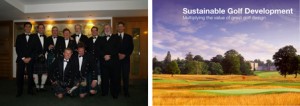Golf course architects unite to promote sustainable golf development
In late March there was a very significant meeting of minds at The World Golf Forum of Golf Course Architects, St Andrews University in St Andrews, Scotland. The initiatives discussed at this conference will have very positive long term benefits for golf development in Australia and the Asia Pacific Region. There are many challenges facing the construction of new golf courses in
Australia including the perceptions that Australia already has too many courses and that golf courses are damaging to the environment.
How to overcome these perceptions was discussed openly at the Forum in St Andrews, where 150 Golf Architects and Industry Leaders from Australia, Japan, the USA, UK and Europe gathered to share their experiences and knowledge. The outcome of The Forum was a consensus that we need to work closely together to present the positive community and environmental benefits of golf.
That these common perceptions of golf are not true and can be easily refuted by science provided the underpinning for the creation of GEO – Golf Environment Organization, a not for profit organization that was established to be a central voice in this debate. Backed by major golf, governmental and environmental bodies including The R&A (The Royal and Ancient Golf Club of St Andrews ), the Club Managers Association’s of America, Europe and China, the European Tour,
The Asian Golf Industry Federation, The World Wildlife Fund, the United Nations Environment Programme, the world’s Golf Course Architects and other industry groups, GEO will become a central figure in scientifically proving the benefits of golf whilst promoting world’s best practice for the design, construction and maintenance of golf courses.
In his address to the forum, GEO’s Jonathan Smith introduced the GEO’s Sustainable Golf Development guidance project which is aimed to support all stakeholders in realizing sustainable golf developments. This would be achieved by drawing together a clear and cohesive framework of technical issues and opportunities by providing practical solutions backed by scientific research.
This guidance will cover all phases of the development process and provide informed feedback to the industry. GEO will provide information to both developers and those who regulate the planning process. Developers need to understand the principles of sustainability whist regulators need to get a better understanding of what a golf development is all about and how to rationally determine if a specific proposal is sound in sustainability terms. It is hoped that with all industry parties working together globally, sharing an enormous body of experience, the quality of golf course proposals will continue to improve and the various planning regulators will be much better informed and able to support projects with the comfort of knowing that they are responsible projects and will achieve high standards of social, economic and environmental return on investment.
In Australia, planning new golf courses is particularly difficult in large part due to an overly bureaucratic planning environment. Planning in Australia is a state responsibility and there is very little common ground between the various state systems. The planning environment is expensive, time consuming and uncertain which discourages developers from entertaining golf course development. Perhaps this is part of the regulator’s grand plan. The planning process has also been corrupted by some perceptions that the golf industry is not responsible environmentally. This is despite the many fine examples of site restoration, habitat creation, re-use of effluent water and the fact that golf is one of the highest participation sports in Australia with obvious heath benefits. It is also frustrating that in Australia it is almost impossible to develop near the coast as our enormous coastline is wrapped by either National Park and or Coastal reserve with very little private land abutting the coast. This is particularly ironic as the game of golf began ‘on the coast’ over 500 years ago and has been a wonderful custodian of sensitive coastal ecosystems for centuries. Australia is a sporting nation and we are blessed with an abundance of beaches, sporting grounds and golf courses but not necessarily in the areas we now live. Australia is now a urbanized nation with nearly 90% of the population living in rapidly expanding cities.
Most of the population growth is being accommodated on the urban fringe of our major cities and these people are being deprived of the opportunity of easy access to golf. For example, Melbourne is expanding rapidly in a south easterly direction with the Pakenham corridor planned to house an additional 150,000 people by 2030, yet there is no provision in the planning scheme for any golf courses. Conversely the shrinking rural populations are more than adequately provided for with golf and other sporting facilities but do not have sustainable levels of participation. Currently Australia has on average a golf course for every 14,000 residents. At this ratio the Pakenham Corridor could legitimately support 10 courses. This is especially so on the basis of the likely demographic of its residents. Over the past decade there have been some significant golf course developments in Australia that demonstrate that sustainable golf courses can be built and have set a new benchmark for the next generation of projects. These Include Barnbougle Dunes at Bridport Tasmania; The National Golf Club at Cape Schanck , Victoria; Magenta Shores and The Entrance in NSW and The Hamilton Island Golf Course in Queensland. With an ever increasing commitment to the environment golfers have a lot to look forward to as more sustainable golf courses become the norm.

